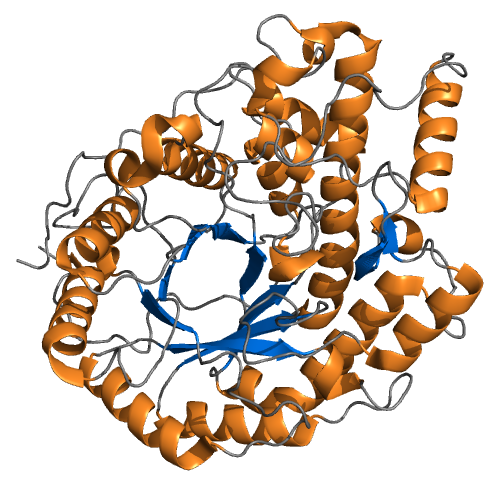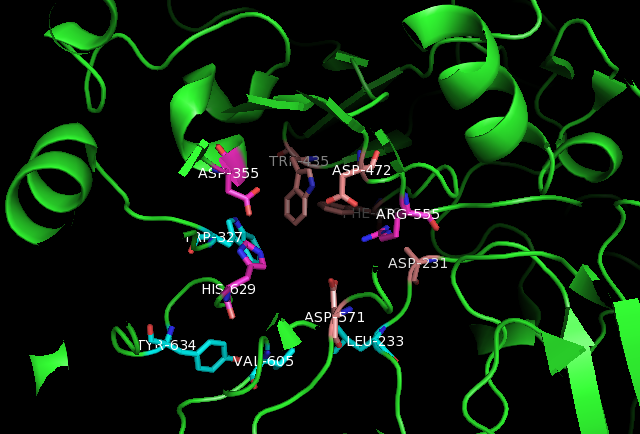|
Glucosidases
Glucosidases are the glycoside hydrolase enzymes categorized under the EC number 3.2.1. Function Alpha-glucosidases are enzymes involved in breaking down complex carbohydrates such as starch and glycogen into their monomers. They catalyze the cleavage of individual glucosyl residues from various glycoconjugates including alpha- or beta-linked polymers of glucose. This enzyme convert complex sugars into simpler ones. Members Different sources include different members in this class. Members marked with a "#" are considered by MeSH to be glucosidases. Clinical significance Alpha-glucosidases are targeted by alpha-glucosidase inhibitors such as acarbose and miglitol to control diabetes mellitus type 2. See also * DNA glycosylases * Mucopolysaccharidoses Mucopolysaccharidoses are a group of metabolic disorders caused by the absence or malfunctioning of lysosomal enzymes needed to break down molecules called glycosaminoglycans (GAGs). These long chains of sugar carbohydra ... [...More Info...] [...Related Items...] OR: [Wikipedia] [Google] [Baidu] |
Alpha-glucosidase
α-Glucosidase (EC 3.2.1.20, maltase, glucoinvertase, glucosidosucrase, maltase-glucoamylase, α-glucopyranosidase, glucosidoinvertase, α-D-glucosidase, α-glucoside hydrolase, α-1,4-glucosidase, α-D-glucoside glucohydrolase; systematic name α-D-glucoside glucohydrolase) is a glucosidase located in the brush border of the small intestine that acts upon α(1→4) bonds: : Hydrolysis of terminal, non-reducing (1→4)-linked α-D-glucose residues with release of D-glucose This is in contrast to β-glucosidase. α-Glucosidase breaks down starch and disaccharides to glucose. Other glucosidases include: * Cellulase * Beta-glucosidase * Debranching enzyme Mechanism α-Glucosidase hydrolyzes terminal non-reducing (1→4)-linked α-glucose residues to release a single α-glucose molecule. α-Glucosidase is a carbohydrate-hydrolase that releases α-glucose as opposed to β-glucose. β-Glucose residues can be released by glucoamylase, a functionally similar enzyme. The substr ... [...More Info...] [...Related Items...] OR: [Wikipedia] [Google] [Baidu] |
Acid α-glucosidase
α-Glucosidase (EC 3.2.1.20, maltase, glucoinvertase, glucosidosucrase, maltase-glucoamylase, α-glucopyranosidase, glucosidoinvertase, α-D-glucosidase, α-glucoside hydrolase, α-1,4-glucosidase, α-D-glucoside glucohydrolase; systematic name α-D-glucoside glucohydrolase) is a glucosidase located in the brush border of the small intestine that acts upon α(1→4) bonds: : Hydrolysis of terminal, non-reducing (1→4)-linked α-D-glucose residues with release of D-glucose This is in contrast to β-glucosidase. α-Glucosidase breaks down starch and disaccharides to glucose. Other glucosidases include: * Cellulase * Beta-glucosidase * Debranching enzyme Mechanism α-Glucosidase hydrolyzes terminal non-reducing (1→4)-linked α-glucose residues to release a single α-glucose molecule. α-Glucosidase is a carbohydrate-hydrolase that releases α-glucose as opposed to β-glucose. β-Glucose residues can be released by glucoamylase, a functionally similar enzyme. The substr ... [...More Info...] [...Related Items...] OR: [Wikipedia] [Google] [Baidu] |
Mannosyl-oligosaccharide Glucosidase
Mannosyl-oligosaccharide glucosidase (MOGS) (, ''processing alpha-glucosidase I,'' ''Glc3Man9NAc2 oligosaccharide glucosidase'', ''trimming glucosidase I, GCS1'') is an enzyme with systematic name ''mannosyl-oligosaccharide glucohydrolase''. MOGS is a transmembrane protein found in the membrane of the endoplasmic reticulum of eukaryotic cells. Biologically, it functions within the N-glycosylation pathway. Enzyme mechanism MOGS is a glycoside hydrolase enzyme, belonging to Family 63 as classified within the Carbohydrate-Active Enzyme database. This enzyme catalyses the following chemical reaction: : Exohydrolysis of the non-reducing terminal glucose residue in the mannosyl-oligosaccharide glycan Glc3Man9GlcNAc2 This reaction is the first trimming step in the N-glycosylation pathway. Prior to this, the glycan was co-translationally attached to a nascent protein by the oligosaccharyltransferase complex. MOGS removes the terminal glucose residue, leaving the glycoprotein link ... [...More Info...] [...Related Items...] OR: [Wikipedia] [Google] [Baidu] |
Beta-glucosidase
β-Glucosidase (EC 3.2.1.21; systematic name β-D-glucoside glucohydrolase) is an enzyme that catalyses the following reaction: : Hydrolysis of terminal, non-reducing β-D-glucosyl residues with release of β-D-glucose Structure β-Glucosidase is composed of two polypeptide chains. Each chain is made up of 438 amino acids and constitute a subunit of the enzyme. Each of these subunits contains an active site. The active site has three potential components: the pocket, the cleft, and the tunnel. The pocket structure is beneficial for recognition of monosaccharide like glucose. The cleft allows for binding of sugars to form polysaccharides. The tunnel allows for the enzyme to attach to polysaccharide and then release product while still attached to the sugar. Function The function of the enzyme is to perform hydrolysis of various glycosides and oligosaccharides. The most significant oligosaccharide β-glucosidase reacts with is cellulose. Cellulose is a polymer composed of β-1 ... [...More Info...] [...Related Items...] OR: [Wikipedia] [Google] [Baidu] |
Glycoside Hydrolase
Glycoside hydrolases (also called glycosidases or glycosyl hydrolases) catalyze the hydrolysis of glycosidic bonds in complex sugars. They are extremely common enzymes with roles in nature including degradation of biomass such as cellulose (cellulase), hemicellulose, and starch (amylase), in anti-bacterial defense strategies (e.g., lysozyme), in pathogenesis mechanisms (e.g., viral neuraminidases) and in normal cellular function (e.g., trimming mannosidases involved in N-linked glycoprotein biosynthesis). Together with glycosyltransferases, glycosidases form the major catalytic machinery for the synthesis and breakage of glycosidic bonds. Occurrence and importance Glycoside hydrolases are found in essentially all domains of life. In prokaryotes, they are found both as intracellular and extracellular enzymes that are largely involved in nutrient acquisition. One of the important occurrences of glycoside hydrolases in bacteria is the enzyme beta-galactosidase (LacZ), which i ... [...More Info...] [...Related Items...] OR: [Wikipedia] [Google] [Baidu] |
Cellulase
Cellulase (EC 3.2.1.4; systematic name 4-β-D-glucan 4-glucanohydrolase) is any of several enzymes produced chiefly by fungi, bacteria, and protozoans that catalyze cellulolysis, the decomposition of cellulose and of some related polysaccharides: : Endohydrolysis of (1→4)-β-D-glucosidic linkages in cellulose, lichenin and cereal β-D-glucan The name is also used for any naturally occurring mixture or complex of various such enzymes, that act serially or synergistically to decompose cellulosic material. Cellulases break down the cellulose molecule into monosaccharides ("simple sugars") such as β-glucose, or shorter polysaccharides and oligosaccharides. Cellulose breakdown is of considerable economic importance, because it makes a major constituent of plants available for consumption and use in chemical reactions. The specific reaction involved is the hydrolysis of the 1,4-β-D-glycosidic linkages in cellulose, hemicellulose, lichenin, and cereal β-D-glucans. Because cell ... [...More Info...] [...Related Items...] OR: [Wikipedia] [Google] [Baidu] |
Cellulose
Cellulose is an organic compound with the formula , a polysaccharide consisting of a linear chain of several hundred to many thousands of β(1→4) linked D-glucose units. Cellulose is an important structural component of the primary cell wall of green plants, many forms of algae and the oomycetes. Some species of bacteria secrete it to form biofilms. Cellulose is the most abundant organic polymer on Earth. The cellulose content of cotton fiber is 90%, that of wood is 40–50%, and that of dried hemp is approximately 57%. Cellulose is mainly used to produce paperboard and paper. Smaller quantities are converted into a wide variety of derivative products such as cellophane and rayon. Conversion of cellulose from energy crops into biofuels such as cellulosic ethanol is under development as a renewable fuel source. Cellulose for industrial use is mainly obtained from wood pulp and cotton. Some animals, particularly ruminants and termites, can digest cellulose with the help of ... [...More Info...] [...Related Items...] OR: [Wikipedia] [Google] [Baidu] |
Sucrase-isomaltase
Oligo-1,6-glucosidase (EC 3.2.1.10, sucrase-isomaltase, SI; systematic name oligosaccharide 6-α-glucohydrolase) is a glucosidase enzyme located on the brush border of the small intestine, which catalyses the following reaction: :Hydrolysis of (1→6)-α-D-glucosidic linkages in some oligosaccharides produced from starch and glycogen by (α-amylase), and in isomaltose It is a dual-function enzyme with two GH31 domains, one serving as the isomaltase, the other as a sucrose alpha-glucosidase. It has preferential expression in the apical membranes of enterocytes. The enzyme’s purpose is to digest dietary carbohydrates such as starch, sucrose and isomaltose. By further processing the broken-down products, energy in the form of ATP can be generated.Berg, J. M. et al. ''Biochemistry'', 7th Ed. W.H. Freeman and Company: New York, 2012. Structure Sucrase-isomaltase consists of two enzymatic subunits: sucrase and isomaltase. The subunits originate from a polypeptide precurs ... [...More Info...] [...Related Items...] OR: [Wikipedia] [Google] [Baidu] |
Congenital Disorder Of Glycosylation
A congenital disorder of glycosylation (previously called carbohydrate-deficient glycoprotein syndrome) is one of several rare inborn errors of metabolism in which glycosylation of a variety of tissue proteins and/or lipids is deficient or defective. Congenital disorders of glycosylation are sometimes known as CDG syndromes. They often cause serious, sometimes fatal, malfunction of several different organ systems (especially the nervous system, muscles, and intestines) in affected infants. The most common sub-type is PMM2-CDG (formally known as CDG-Ia) where the genetic defect leads to the loss of phosphomannomutase 2 (PMM2), the enzyme responsible for the conversion of mannose-6-phosphate into mannose-1-phosphate. Presentation The specific problems produced differ according to the particular abnormal synthesis involved. Common manifestations include ataxia; seizures; retinopathy; liver disease; coagulopathies; failure to thrive (FTT); dysmorphic features (''e.g.,'' inverted nip ... [...More Info...] [...Related Items...] OR: [Wikipedia] [Google] [Baidu] |
2xfr B Amylase
Jaguar XF may refer to: *Jaguar XF (X250) (2007–2015), an executive/luxury mid-size sports sedan car *Jaguar XF (X260) The Jaguar XF (X260) is an executive/ mid-size luxury sports saloon manufactured and marketed by the Jaguar Cars brand of Jaguar Land Rover in sedan/saloon and station wagon/estate body styles. Following the first generation steel-bodied X250 ... (2015–present), another executive/mid-size luxury sports sedan car {{set index article XF ... [...More Info...] [...Related Items...] OR: [Wikipedia] [Google] [Baidu] |
Glycogen Storage Disease Type II
Glycogen storage disease type II, also called Pompe disease, is an autosomal recessive metabolic disorder which damages muscle and nerve cells throughout the body. It is caused by an accumulation of glycogen in the lysosome due to deficiency of the lysosomal acid alpha-glucosidase enzyme. It is the only glycogen storage disease with a defect in lysosomal metabolism, and the first glycogen storage disease to be identified, in 1932 by the Dutch pathologist J. C. Pompe. The build-up of glycogen causes progressive muscle weakness (myopathy) throughout the body and affects various body tissues, particularly in the heart, skeletal muscles, liver and the nervous system. Signs and symptoms Newborn The infantile form usually comes to medical attention within the first few months of life. The usual presenting features are cardiomegaly (92%), hypotonia (88%), cardiomyopathy (88%), respiratory distress (78%), muscle weakness (63%), feeding difficulties (57%) and failure to thrive (50%). ... [...More Info...] [...Related Items...] OR: [Wikipedia] [Google] [Baidu] |
Lactase
Lactase is an enzyme produced by many organisms. It is located in the brush border of the small intestine of humans and other mammals. Lactase is essential to the complete digestion of whole milk; it breaks down lactose, a sugar which gives milk its sweetness. People who have deficiency of lactase, and consume dairy products, may experience the symptoms of lactose intolerance. Lactase can be purchased as a food supplement, and is added to milk to produce "lactose-free" milk products. Lactase (also known as lactase-phlorizin hydrolase, or LPH), a part of the β-galactosidase family of enzymes, is a glycoside hydrolase involved in the hydrolysis of the disaccharide lactose into constituent galactose and glucose monomers. Lactase is present predominantly along the brush border membrane of the differentiated enterocytes lining the villi of the small intestine. In humans, lactase is encoded by the LCT gene on chromosome 2. Uses Food use Lactase is an enzyme that some people are ... [...More Info...] [...Related Items...] OR: [Wikipedia] [Google] [Baidu] |




